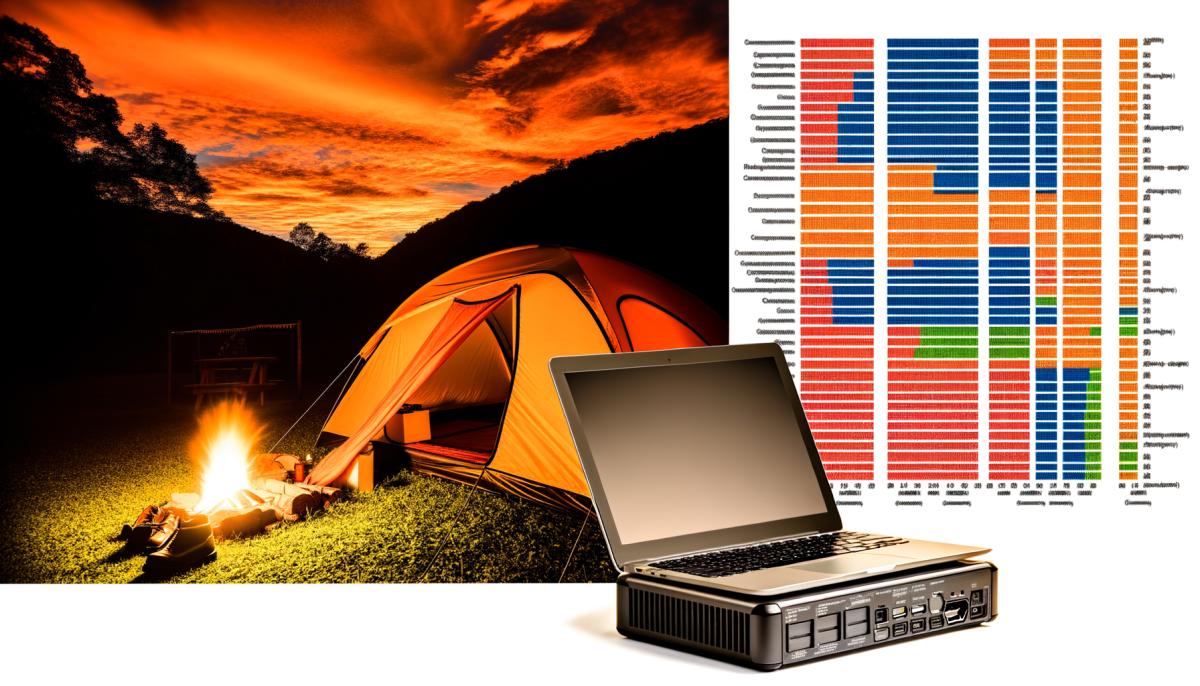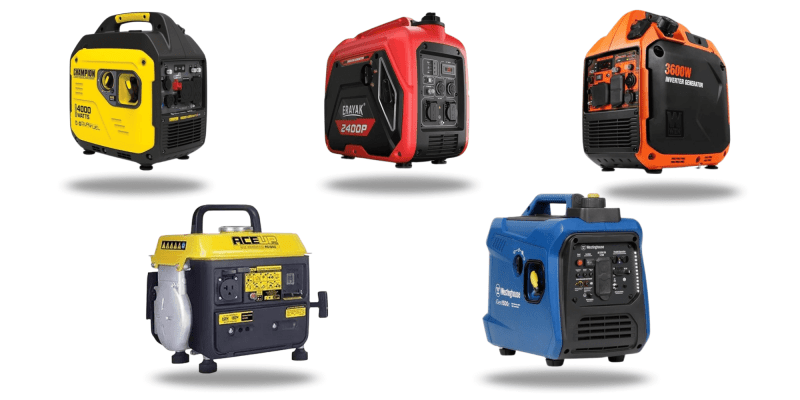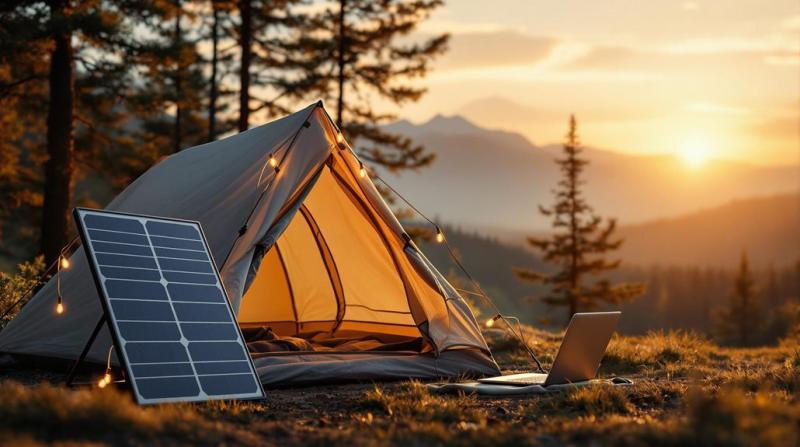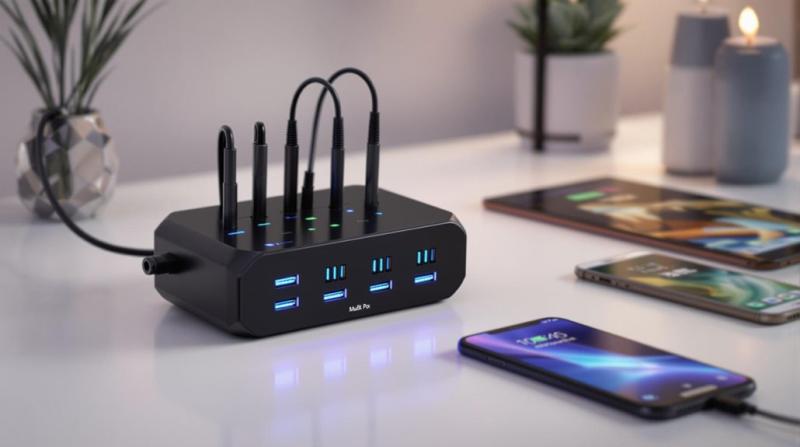When you're picking out a portable power station, understanding battery capacity is super important.
Battery capacity is measured in watt-hours (Wh), and it basically tells you how long you can keep your devices running before you need to recharge. The higher the capacity, the better it is for running larger appliances. But, keep in mind, efficiency can change depending on the battery type and the output options available.
Now, here's something to think about: factors like inverter quality and consistent power delivery are huge when it comes to performance, especially if you've got high-demand gadgets.
High-capacity models are awesome because they let you use your stuff for longer. But, watch out—they can be pretty heavy and pricey.
Really, you've got to evaluate your needs carefully. Who knows? You might just find the perfect match for your adventures and emergencies. There's a whole lot more to uncover about these powerhouses!
Importance of Battery Capacity
When you're picking out a portable power station, knowing a bit about battery capacity is super important. It directly affects how long you can keep your gadgets running before you need to recharge. So, here's the deal: battery capacity is measured in watt-hours (Wh), which tells you how much energy the battery can store. The bigger the number, the longer your stuff stays powered.
Think about this—if you're heading out for a weekend camping trip with things like laptops or coolers, you'll want a power station with a higher capacity. You definitely don't want to be left with dead devices in the middle of nowhere, right?
Now, let's talk about the type of devices you'll be using. Different gadgets need different amounts of power. For example, your smartphone might only need around 5-10 watts, but a mini-fridge could gulp down 50-100 watts or even more. So, figuring out what your devices require will help you pick a power station with the right battery capacity.
And here's another thing—battery capacity can degrade over time. Most portable power stations use lithium-ion batteries, and these lose their charge-holding ability after a certain number of cycles. This could impact how useful your power station is in the long run. So, think about not just what you need right now, but also how often you'll be using it down the road.
In the end, understanding battery capacity helps you make smarter choices that fit your needs and usage habits. You'll get the most out of your portable power station, keeping your gadgets running efficiently and reliably.
Key Factors Affecting Capacity
What influences the capacity of your portable power station is crucial to consider, as several key factors can significantly affect its overall performance and longevity.
So, let's break it down.
First off, the type of battery chemistry plays a big role. You see, lithium-ion batteries, which are pretty common in portable power stations, deliver higher energy density and efficiency compared to lead-acid batteries. This just means you can store more energy in a smaller space—super important for portability.
Next up, the battery's amp-hour (Ah) rating is also a big deal. A higher Ah rating means the battery can sustain a load for a longer duration. So, you can power multiple devices for extended periods—pretty handy, right?
And don't forget about the inverter quality. A pure sine wave inverter provides cleaner power for sensitive electronics and can handle higher loads without straining the system. That's good news for your gadgets!
Now, let's talk temperature. Extreme cold or heat can mess with battery efficiency and capacity, limiting how much power you can draw. Not ideal. Regular maintenance can help keep your battery in tip-top shape, ensuring it operates at its best capacity.
And finally, how you use your power station—like the devices you connect and the load you put on the system—can impact its performance.
Comparing Power Station Models
When you're comparing power station models, it's super important to check out their capacity ratings. That way, you can figure out how much energy they'll actually provide for your devices.
And hey, don't forget to think about their versatility! Depending on what you need—like a camping trip or emergency backup—you might want different features.
Capacity Ratings Comparison
Evaluating the capacity ratings of various portable power stations reveals some really important insights into their performance and how well they'll suit your power needs. These power stations usually have capacities measured in watt-hours (Wh). This measurement directly tells you how long a station can keep your devices running before it needs to be recharged. Pretty handy, right?
When you start comparing models, don't just look at the total capacity. Pay attention to the output capabilities as well. A higher capacity doesn't always mean better performance. For example, you might find a power station with a 500Wh rating that can run a few smaller gadgets just fine, but it could struggle if you try to power up larger appliances. That's because of its output limitations.
Also, don't forget about the inverter rating. This determines how much power the station can supply at any given moment. If you're planning to use it for outdoor activities or emergencies, you might want something with high surge capabilities to power things like refrigerators or power tools. Those devices need a lot of juice!
On the other hand, if you're just charging phones or tablets, a model with less capacity might do the trick. By taking a close look at these ratings, you'll be able to figure out which power station will meet your specific needs. That way, you'll never be left in the dark—literally!
Versatility for Different Needs
Versatility is super important when you're picking out a portable power station. Different models are designed to meet a variety of power needs, whether you're just looking to charge your smartphone or you need something that can handle bigger appliances during outdoor trips or emergencies.
You'll come across power stations with all kinds of output options—think AC outlets, USB ports, and DC outputs. This means you can hook up multiple devices at once, which is pretty handy.
Now, when you're comparing models, pay attention to their output wattage and capacity. For example, a portable power station with a 500W output can easily run most laptops and small kitchen gadgets. But if you need to power something more demanding, like an electric cooler or power tools, you might want to look at models with a 1000W output.
And don't forget to check out the battery type and technology. Lithium-ion batteries are generally more efficient and last longer than the old-school lead-acid ones.
Oh, and here's another thing to keep in mind: the weight and size of the power station. If you're planning on camping or hiking, you'll probably want something lightweight and compact.
On the flip side, if you're looking for a backup power source for home use, a bigger model might be more up your alley. Ultimately, it's all about figuring out your specific needs and how you plan to use the power station. That way, you can pick a versatile model that delivers exactly what you need, ensuring you're ready for whatever comes your way.
Analyzing Performance in Real Use
When you put a portable power station to the test in everyday scenarios, its true capabilities really come to light.
You'll want to keep an eye on how consistently it delivers power under load. I mean, nobody wants their gadgets suddenly shutting down, right?
Also, watch how quickly it charges your devices.
These factors are super important in figuring out if a model actually meets your needs in real-world situations.
Real-World Usage Scenarios
You know, in real-world situations, portable power stations are like your best buddy when you're out camping, facing an emergency, or hosting an outdoor event. These handy devices can keep your smartphones, laptops, and even small appliances like mini-fridges or coffee makers running. So, whether you're deep in the woods or just need to stay connected and comfy, they've got your back.
I mean, think about it. Heading into the wilderness, you might be scratching your head, wondering just how much battery capacity you'll need. For a quick weekend camping trip, most of these power stations are more than capable of handling a few device charges and keeping the lights on. But if you're planning to stay out there longer or need to power bigger stuff, you gotta sit down and really figure out what you need, then pick a model with the right capacity.
And hey, those unexpected power outages? Yeah, they're a real pain. But having a reliable power station can make all the difference. It can keep your home essentials running, whether it's lighting up your space or making sure your food stays fresh. Basically, a solid power station can help you keep things running smoothly when things go sideways.
Power Output Consistency
Power stations need to deliver consistent output to guarantee your devices run smoothly, especially during critical moments like camping trips or power outages.
So, when you're thinking about getting a portable power station, it's super important to check if it can keep a stable voltage and current. Because, let's face it, fluctuations can be a real pain and might cause your devices to malfunction. And that could be a disaster, especially if you're depending on them for communication, lighting, or even medical devices.
When you're putting these units to the test in real-world scenarios, take a good look at how they handle different loads. For example, does the output dip a lot when you connect multiple devices? You definitely want a power station that can handle high demand without breaking a sweat. This is especially true if you plan on running high-draw appliances like refrigerators or power tools.
Also, don't forget to check out the quality of the inverter. A good inverter will make sure you get a clean and reliable power supply.
Oh, and keep an eye on things like thermal management and battery management systems too. These are key factors in maintaining that oh-so-important output consistency.
Charging Speed Efficiency
Charging speed efficiency is super important because it determines how quickly you can get your devices up and running. Seriously, it's an essential factor to consider in real-world scenarios. When you're evaluating portable power stations, don't just look at the capacity—check out how fast they can deliver power too. Some models have big battery capacities but lag in actual charging speeds, leaving you waiting longer than you'd like.
So, what should you look for? Fast-charging ports and built-in technology that optimizes energy transfer. Trust me, it makes a difference. For example, USB-C PD support can really speed things up for compatible devices. Imagine you're camping or traveling; that extra time saved could mean the difference between enjoying your tech or dealing with frustrating downtime.
Oh, and here's a tip: don't overlook the impact of ambient temperature and the age of the battery on charging speed. Batteries can underperform if they're too cold or too hot. So, make sure you choose a power station that can handle various climates.
Pros and Cons of High Capacity
High-capacity portable power stations are pretty awesome. They let you run multiple devices at the same time and power up your adventures without a hitch. Whether you're camping, tailgating, or dealing with a power outage, having one of these bad boys can really make a difference. You can charge smartphones, laptops, and even small appliances all at once, bringing the comforts of home to wherever you are.
But, let's break it down a bit. One big plus is the extended run time. You won't have to keep recharging or worrying about power levels, which means less stress for you. Plus, these power stations usually come with various output options, making them compatible with a bunch of different devices. This kind of flexibility can save you from lugging around multiple chargers or adapters.
Now, on the flip side, high-capacity power stations can be pretty bulky and heavy. Not exactly ideal if you're planning a short hike and don't want to be weighed down. And let's be real, these models can be pricey, which might be a turn-off if you're on a budget. Also, keep in mind that charging these high-capacity batteries can take a while, so you'll need to plan your recharging sessions.
In the end, you gotta weigh these pros and cons to see if a high-capacity power station fits your needs and lifestyle. If you're always on the go or need a lot of power, it might be worth the investment. But definitely think about how you'll use it to make sure it won't cause more hassle than it's worth.
Future Trends in Battery Technology
So, when you're weighing the pros and cons of high-capacity power stations, it's super interesting to think about how future advancements in battery tech might totally change the game.
One of the coolest trends to watch is the development of solid-state batteries. These could really boost energy density and safety. Unlike the usual lithium-ion batteries, solid-state ones use a solid electrolyte. This means fewer leaks and fires, plus way better storage. Imagine having power stations that last longer, charge faster, and can endure more cycles before they start to degrade. Pretty awesome, right?
And get this, another really exciting area is the integration of renewable energy technologies. Picture a scenario where your portable power station can easily tap into solar energy or even kinetic energy while you're using it. This would make them super sustainable. This hybrid approach could cut down your dependency on grid power and boost efficiency. So, your outdoor adventures become not just fun but also eco-friendly. How cool is that?
But wait, there's more! Advancements in battery management systems are gearing up to make devices way smarter and more intuitive. Imagine having real-time monitoring and AI-driven optimizations right at your fingertips. You'd get super reliable performance insights, making your overall experience a whole lot better.
And let's not forget, researchers are diving into alternative materials like sodium-ion or graphene batteries. This could mean lower costs and more availability, making high-capacity power stations accessible to more people.
Keep an eye on these trends because they're set to change how you think about portable energy solutions. Seriously, the landscape of portable power stations is about to get a whole lot more exciting!



